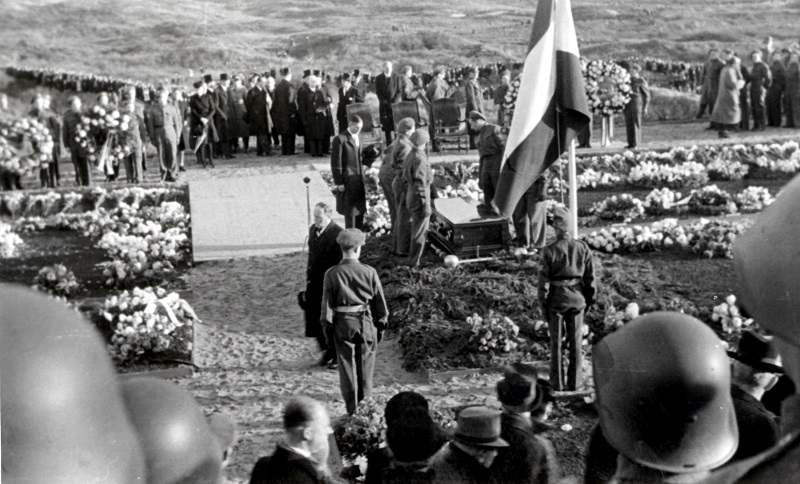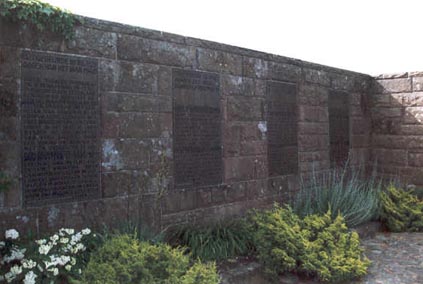cemetery of honor Bloemendaal
‘In these dunes our dead sleep’
When summer returns and we cycle en masse through the dunes towards the sea, we can hardly imagine it. Yet it happened here, in our own Kennemer Dunes. Where the hawthorn now blooms and the sea breeze shaves the beach grass, hundreds of Dutch people, who for whatever reason got in the way of the occupying forces—sometimes dozens at a time, sometimes alone—were killed. Murdered. Or dumped.
In the May days of 1945, they were found: 422 people. Most of them died in the final months before liberation. Eight large memorial stones, one hidden in an overgrown dune hollow, another standing starkly at the edge of a cycle path, still commemorate the sites. These stones list, with stifling simplicity, the number of murdered resistance fighters buried in and around that spot.
Shortly after liberation, the first mass graves were discovered. There are 45 sites in total. The identification was no easy task and was led by the Haarlem surgeon and former resistance fighter Dr. H. Wamsteker. Most of the fallen had been robbed of their clothing and personal belongings. The only clues were the condition of the victims’ teeth. Dentists from all over the country cooperated, so that the identification was ultimately successful.
The statements of the captured NSB undertaker, who was supposed to take the people murdered by the Germans to the dunes and leave them there “properly,” and his meticulously kept lists also helped locate and identify the victims. The identities of only two people remain unknown. This operation took months, and hundreds of volunteers worked day and night to pay their last respects to the fallen.
A total of 422 people were found in the dunes.
Reburial
The first reburial at the Honorary Cemetery took place on November 27, 1945, in the presence of the royal family; the last interment took place ten years later.
There are 372 graves.
One woman among them: Hannie Schaft.

Reburial at Bloemendaal Cemetery of Honor
Victims were also buried at the request of family members at their place of residence or at the place of execution. Conversely, fallen soldiers were buried together with comrades from the same resistance group at the Honorary Cemetery.
One gravestone bears the inscription: “In memory of the friends of the resistance who were not found after their fight for freedom or who rest elsewhere.” No remains lie beneath this stone.*
Memorial stones
In 1949, stones were placed at eight sites bearing the inscription: Here lay (number) murdered resistance fighters. These stones, made of Maulbrunner sandstone, were carved by stonemason Toon Lavertu, a 24-year-old stonecutter and his father in the Kennemer dunes. The carving took place at the excavation site. The pre-cut stones were inscribed with inscriptions by “chopping”—the letters are, as it were, laid on the stone—a process that took several weeks. According to Lavertu, it was a major undertaking. “Around us were still the pits where the executions had taken place. They were full of machine gun shells; the ground still breathed murder.”
In the spring of 2000, the sandstone monuments were replaced with red granite memorial stones. The replacement was deemed necessary because six of the eight stones had weathered and crumbled over the years. The two other stones, adopted by the Zandvoort Oranje Nassau Primary School and Hannie Schaft Primary School, were still in good condition but were also replaced to prevent erosion. The municipality of Bloemendaal and the Overveen Cemetery Foundation had decided a year earlier that the memorial stones, weighing approximately 1,700 kg, needed to be replaced. The production, sawn and carved in France, took three months, according to Haarlem stonemason J. Troupin. No relatives were present at the ceremony, only Zandvoort Mayor Van der Heijden and Mrs. Snoeck, Mayor of Bloemendaal. The red granite in the dunes commemorates three small and five large groups of war victims, including Hannie Schaft.
Visit to the Cemetery of Honor
The cemetery is open:
April to September 9am-6pm,
October to March 9am-5pm
Address: Zeeweg 26, Overveen
Website: Eerebegraafplaats Kennemerduinen
The National Hannie Schaft Commemoration takes place every year on the last Sunday in November. In the morning, flowers are laid at Hannie Schaft’s memorial stone.
Message to the living from H.M. van Randwijk
It happened in the May days of 1940…
In the heart of Europe, the spirit from the abyss had bewitched the German nation. Its soldiers, overwhelming in armament and numbers, subdued many peoples through cunning and violence and even overran the Netherlands.
A small number of civilians, our merchant ships at sea, remnants of the army and navy, and the government fled west and from there, together with our allies, continued the fight. In the occupied country, the enemy disbanded the organizations of free citizens, invalidated the laws, threatened the churches, muzzled the press, and prohibited the free practice of science and art.
More than a hundred thousand Dutch Jews were hunted to their deaths, hundreds of thousands of men captured and forced into slavery.
Then, in the midst of the people, men and women stood up…
Against the enemy’s violence, they opposed conviction and faith, against Teutonic paganism the witness of Christianity and humanism, against the organized millions the irreplaceable value of humanity.
Peaceful citizens became arsonists, saboteurs, and spies. They protected freedom of speech in illegal writings, helped the persecuted, defended the rights of parents in education and the free preaching of the Gospel, and safeguarded the human bond of the doctor with his patient against the interference of a power-hungry state.
Thanks to them, the Netherlands in those days, though tortured and humiliated, was nevertheless freer and more resilient than ever.
Declared outlaws by the enemy, working in poorly organized groups, with no other master than conscience, they withstood the attack on our national existence, providing certainty to the doubtful, strength to the weak, and protection to the hunted.
Many of them died in captivity or before the firing squad. Only a few could be laid to rest in the native soil. Remember them with reverence, always.
Do not dwell too long on the sorrow for those we miss…
Do not seek the dead, seek the living. Seek where this people lives and works. See how wide their land is, how high their heavens are, how close the murmur of the mighty sea. In these regions, peace and freedom have flourished. They are the fruits of spiritual purity, honest thinking, charity, and faith. Remember that what was threatened yesterday can be in danger again today and tomorrow. Protect it and be vigilant.
May the paths leading to the silence of our dead remain passable for all who wish to reflect on the value of freedom and justice.
May God help us in this…
H. M. van Randwijk
This text is on the wall of the Honorary Cemetery in Bloemendaal and was written by H.M. van Randwijk, one of the leaders of the resistance group and the illegal newspaper Vrij Nederland.

Wall at the Bloemendaal Cemetery of Honor with the text by Van Randwijk
*This grave was promised by the first board of the ’40-’45 Foundation to Mr. ten Hoope. He was the first administrator of the Honorary Cemetery. Mr. ten Hoope was also closely involved in the excavations immediately after the war and the entire construction of the Honorary Cemetery. He also actively supported the resistance during the war. When Mr. ten Hoope died in 1986, his son, George ten Hoope, also the longtime administrator, claimed the existing agreement. Unfortunately, the Honorary Cemetery had been a private cemetery since the mid-1960s. As a result, no new burials were permitted. For this reason, his son decided on cremation and the scattering of ashes in the scattering field at the Honorary Cemetery.

